Prior to 1960, training at FSI for Foreign Service wives was provided on a “space available” basis. There was also a seminar for wives which focused heavily on protocol. However, during congressional hearings in 1960, Congressman John Rooney (D-NY) declared that training spouses was a waste of taxpayers’ money and effectively canceled FSI services for spouses. However, AAFSW did not agree and lobbied Congress and the Department of State to reinstate funding for training specific to Foreign Service wives. In 1962, Congress agreed to fund the training through the Mutual Education and Cultural Exchange Act. This reactivated the wives’ course at FSI. In November 1962, FSI offered a pilot two-week course for wives called “Overseas Assignment.
Q: In, I think it was about September of ’61, the Foreign Service Institute took an interest in helping the women with training. Could you tell me about that?
June Byrne Spencer
SPENCER: I’d like to because I feel that, rightly or wrongly, I feel that our organization was responsible for pushing the training of wives. It may have come about at some point in the future, but we really pushed it because it was just a major interest of ours. Both in language and in just a training and orientation program. And we did a lot of research, a lot of work on it. We felt that it was a responsibility of the Department of State, that they were simply not listening to the women, just simply didn’t listen. We ourselves in the organization developed seminars and roundtables and one exceptional evening program for 125 women called “An Experiment in Training.” And we also started language groups using FSI tapes.
Q: This was just within the new organization?
SPENCER: Just within the new organization. And I would say that during the period of at least two years, there was no orientation program at the Foreign Service Institute for junior wives due to budgetary restrictions. It was all very complicated. First of all, there was no training for wives. Then legislation was passed, allowing wives to be trained on a space-available basis. But this was just not good enough because there oftentimes was no space available, and certainly not in the language classes. So what we tried to do was to get that particular hated phrase eliminated. And in time it was eliminated. But for a long time, there was just nothing at all in the Foreign Service Institute for the Foreign Service wives. We developed, we tried to determine what would be the best thing for a Foreign Service wife, would she need to know to go out to become a really good representative. So as I say, we had all of these seminars and roundtable discussions. It’s just thrilling to look back and read the efforts of all of these women, ambassadors’ wives, everybody, setting themselves down and trying to think, “What would be the best thing?” We sent letters out to the field. We got back an enormous amount of responses. We incorporated everything into a very good letter and proposal in June of 1961, sent to Roger Jones who was the Deputy Under Secretary of State for Administration. We sent him a letter and then a sample of a training program and some accompanying papers on that.
Comments about the course from the person who conducted the training
When I was given the assignment in 1962 to return to Washington and establish an officially funded course for wives of our officers serving at U.S. diplomatic missions abroad, I saw this as a recognition by the State Department of the tremendous value of the Foreign Service wives and families and their role in our relations not only with our traditional diplomatic associates but also with the new nations of differing cultures and societies that were coming into being in the post-World War II period. The rapidly evolving scene presented new challenges to our able Service and to our long-established traditions. To meet these, the American Foreign Service wife was a valuable asset, a real partner in the Foreign Service, and I welcomed the unusual assignment to help in establishing the official means that would prepare her for that great opportunity and responsibility.
Mary Vance Trent, Foreign Service Officer (Retired)
Letters, Statements, and Newsletters about the training program
1961
S004_01_1961_June_Letter-to-FSAdmin-about-FS-Wives-training S004_02_1961_June_Statement-about-training-for-FS-Wives S004_03_1961_Sept_Training-for-FS-Wives-Update_AAFSW-Newsletter1962
S004_05_1962_Nov_FS-Wives-Training_AAFSW-Newsletter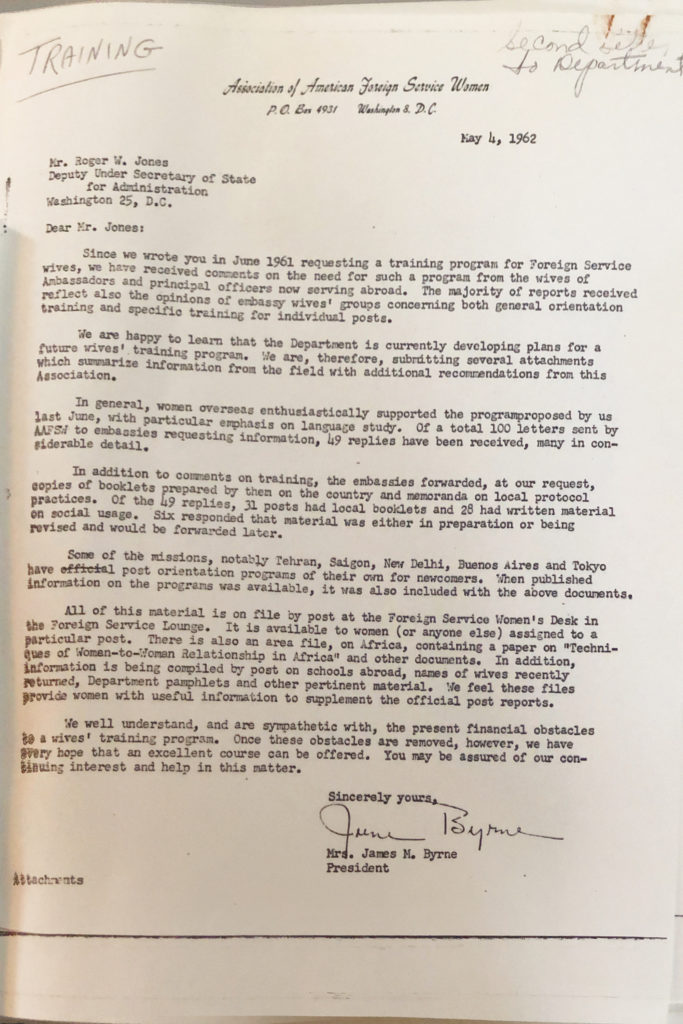
AAFSW letter to Deputy Undersecretary of State for Administration (May 1962) 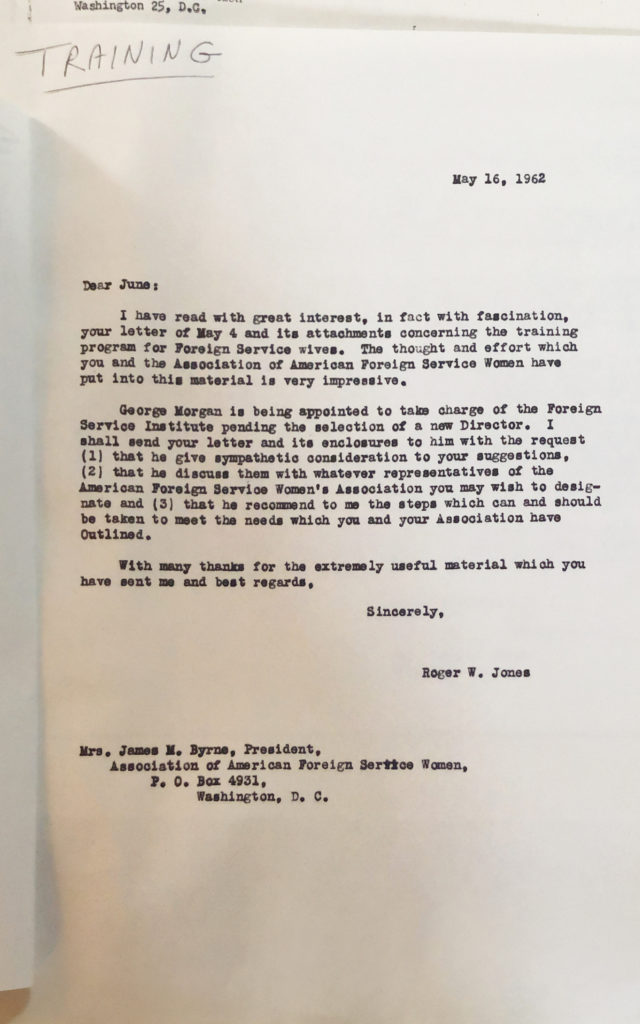
Deputy Undersecretary of State for Administration letter to AAFSW (May 1962) 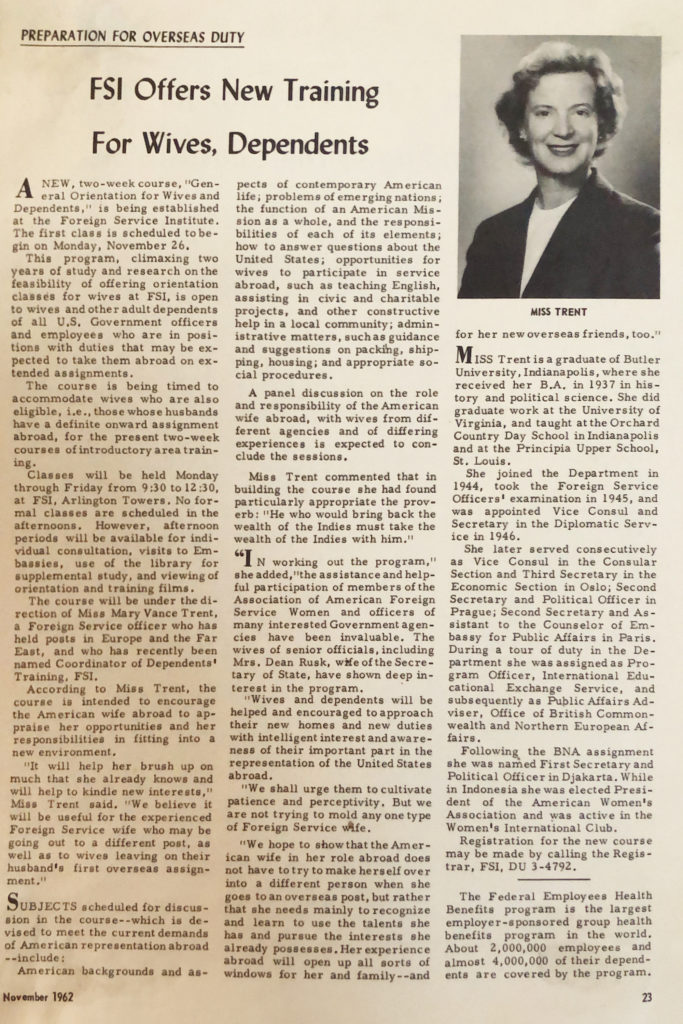
Article in State Dept. newsletter (Nov. 1962) 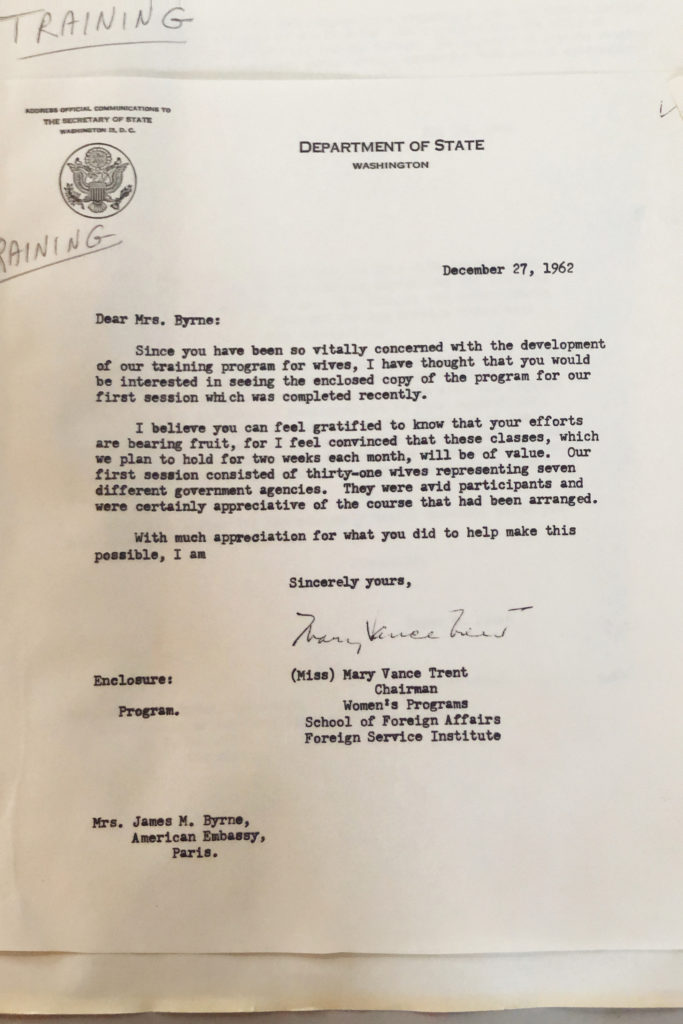
Letter from Mary Vance Trent about the completion of the first training program (Dec. 1962)
1963
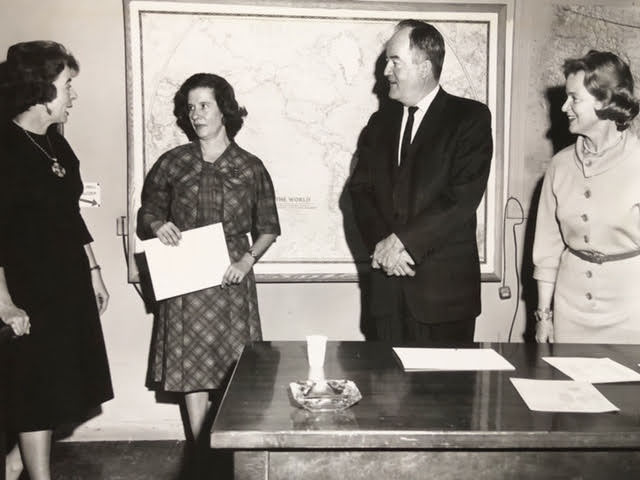
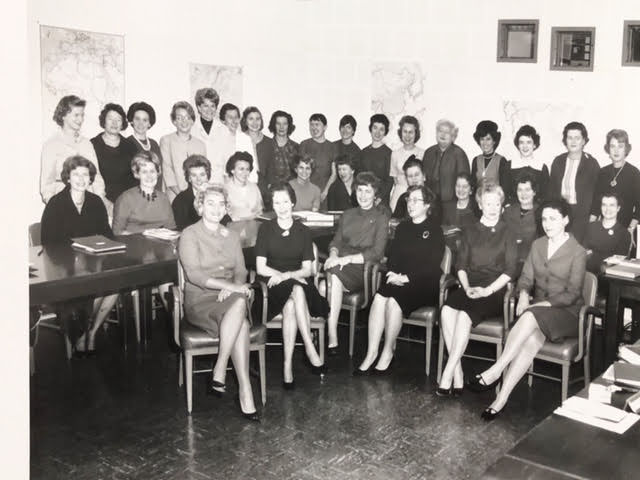
1964
S004_1964_Overseas-Assignment-Course-for-Wives-A-Years-ReviewMedia Coverage
“Most women love being part of the Foreign Service,” says Mrs. Bryne. “In almost no other profession do wives work so closely side by side with their husbands. On the whole, Foreign Service wives are dedicated and uncomplaining but to do an effective job in this vastly changing world, they must be trained.”
Excerpted from Washington Post article entitled “Strength in Unity Says FSO Wives” by Katherine Evans, dated February 4, 1962
“It is only natural that an American wife faced with the prospect of duties and adventures such as these should view an assignment overseas with anxiety and misgivings. Apprehensions are especially sharp among those who have little formal preparation for their foreign roles and no background even of foreign travel. Such women make up the majority of foreign duty wives today.
Excerpted from New York Times article entitled “The Ambassador’s Wife is an Ambassador, Too”, dated October 4, 1964
It has been long apparent that they should be prepared in some organized way for their new roles. In November 1062, State Department officials encouraged by the Association of Foreign Service Women, decided to do something about the problem. The result is a voluntary overseas-assignment course for foreign-bound wives – 30 at a time for an intensive two weeks, 9:30 to 12:30- daily, with optional afternoon activities – at the Foreign Service Institute in Washington.”